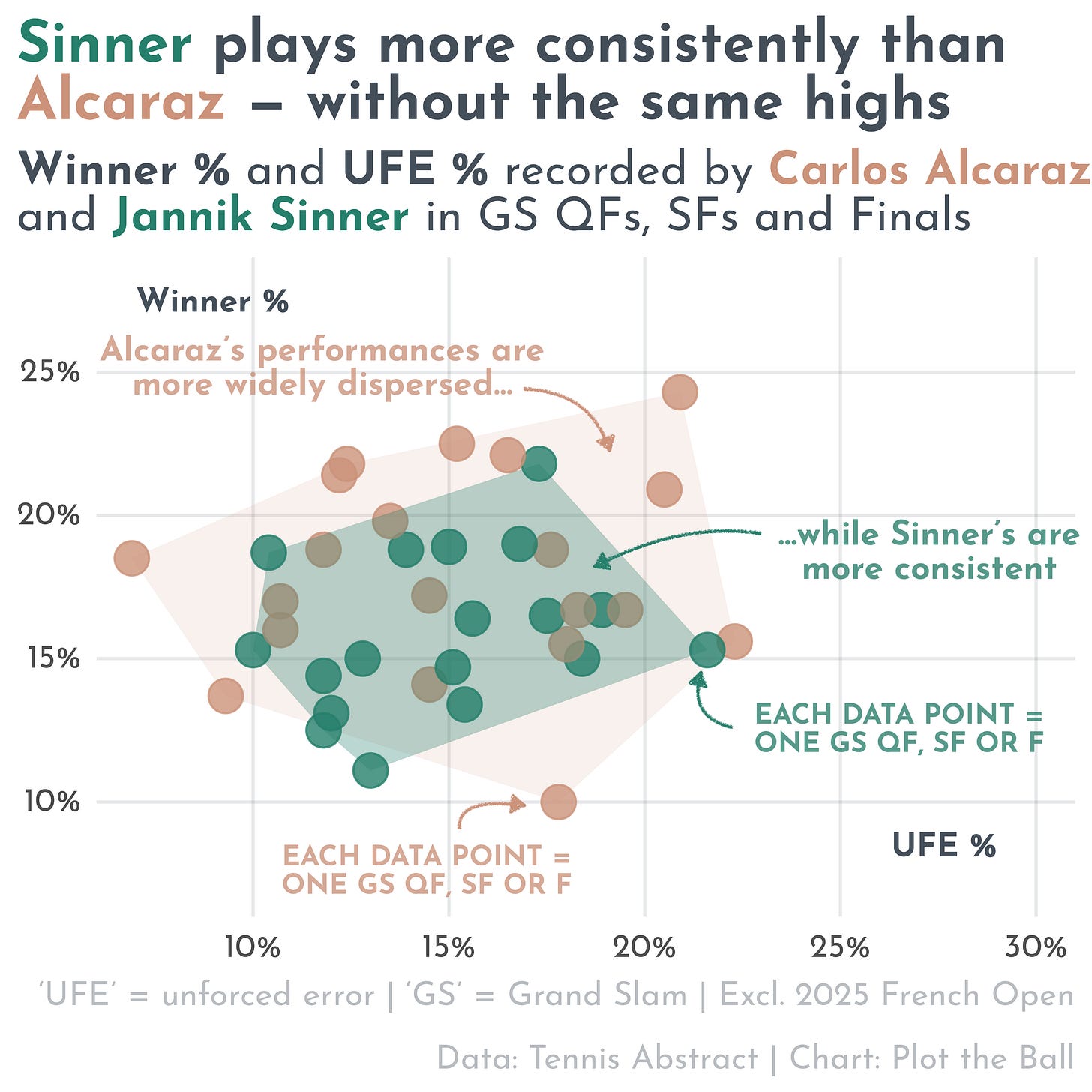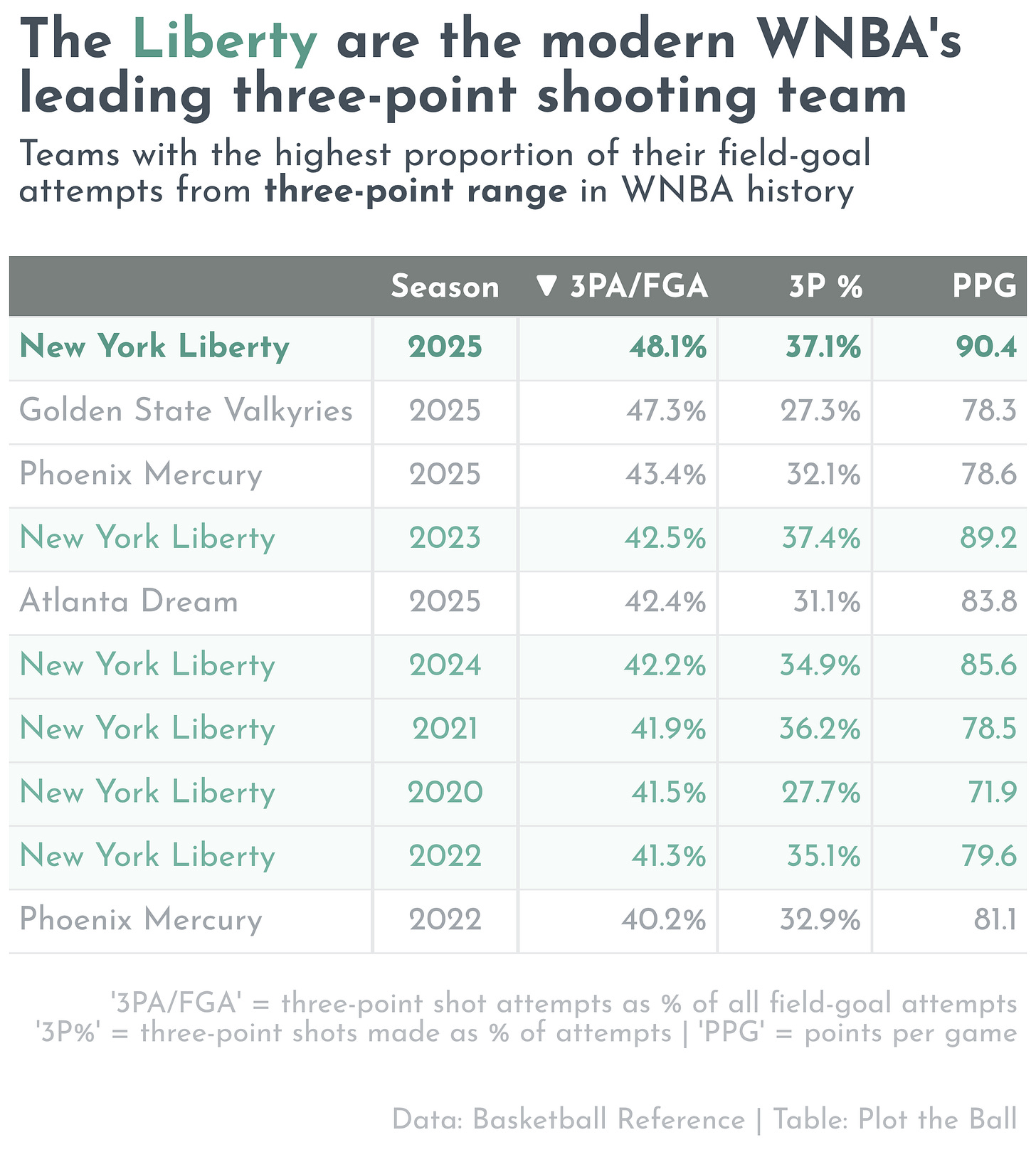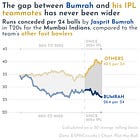🎾 The consistent Jannik Sinner has a crucial role in the new rivalry atop men’s tennis
My Week in Sport(s) 🎾 🏀 ⚾️ ⚽️ 🏏
Welcome to My Week in Sport(s) — a regular newsletter from Plot the Ball.
Covered in this edition: 🎾 Jannik Sinner, 🏀 the New York Liberty, ⚾️ Shohei Ohtani, ⚽️ Clàudia Pina and 🏏 Shubman Gill.
🎾 The consistent Jannik Sinner has a crucial role in the new rivalry atop men’s tennis
I don’t have much time for ‘magic’ metrics. There are always multiple possible paths to victory in a sporting contest — and prescribing a single thing that a team or athlete needs to do in order to win can often collapse that complexity.
In tennis, the ratio of ‘winners’ and ‘unforced errors’ can be discussed in such terms. Tennis Abstract’s Jeff Sackmann has warned his readers against relying too heavily on this ‘magic ratio’ for predictive purposes — but doesn’t make its inputs totally useless. In fact, I think they do a great job of describing the approaches of the two new stars of men’s tennis: Jannik Sinner and Carlos Alcaraz. Watching the pair go head to head — as they did in Paris on Sunday — feels like a classic sporting contrast.
Sinner plays like a competitor with a high floor, and Alcaraz like one with the highest of ceilings. The data available at Tennis Abstract — entering Roland-Garros, at least — speaks to the truth underlying this formulation. Sackmann’s site publishes information on how many winners and unforced errors each player hits in a match as a proportion of all points played; the chart below plots these two metrics for all of the matches Alcaraz and Sinner have played at the quarter-final stage or later in Grand Slams.
Before this year’s French Open, Sinner had recorded both a winner rate and an unforced-error rate between 10% and 20% in 16 of 18 matches. For Alcaraz, both metrics fell within that range only 11 times out of 20. (I will update these figures in a future edition when data from Roland Garros is available.) The Spaniard deviates from the norm on the downside — four of the five worst matches by unforced-error rate are his — but also hits the highest highs, with eight of the best nine by winner rate.
We are firmly in a new era of men’s tennis. Sinner and Alcaraz have now won the last six Grand Slams — and seven of the last eight. In the aftermath of a final like Sunday’s, it’s easy to get carried away with praising the winner’s shot-making and forget just how closely contested it was. Their emerging rivalry is only this compelling because Sinner is an outstanding tennis player in his own right — and the perfect foil to Alcaraz. As I’ve written before in this newsletter, it’s styles that make fights.
🏀 The league-leading Liberty are pushing the boundaries of three-point shooting in the WNBA
A quarter of the way through the WNBA season, last year’s finalists — the New York Liberty and the Minnesota Lynx — are in a tier of their own in the standings. Examine their underlying performances, though, and the Liberty still look decisively stronger.
The champions have won their last 40 regular-season games by an average margin of 11.3 points; over the same period, the Lynx sit at a mark of +6.2 points per game. This year, their early surge has been driven by exceptional offensive play. Only three teams in WNBA history have ever scored more than 90 points per game; the Liberty are averaging 90.4 through nine games. How? By taking — and making — an incredible number of three-pointers. 48% of their shot attempts so far have come from distance.
They’ve always been a team built around outside shooting: entering this year, the five Liberty teams between 2020 and 2024 accounted for the five highest individual team-seasons by this measure in WNBA history. But 2025 marks a significant step forward; in each of the last five years, between 41% and 43% of their shots have been threes. The return of Marine Johannès has helped: averaging 9.1 attempts per 36 minutes, she gives the team another high-volume shooter to pair with Sabrina Ionescu.
What else I learned last week
⚾️ Dodgers DH Shohei Ohtani is making contact earlier in 2025
He’s not back pitching, but Shohei Ohtani continues to generate immense value for the Dodgers as a designated hitter. Once again, he’s squaring up the ball really well: only three major-league hitters have recorded a higher rate of ‘barrels’ so far in 2025.
MLB’s Statcast data also allows us to look at what differentiates Ohtani’s process from other hitters, as well as his outcomes. On average, he has swung the bat faster than all but six other players this year — and, coming into 2025, one of the defining characteristics of his hitting approach was how late he connected with the ball. That’s changed a bit this year, though. Ohtani’s average interception point is still deeper than most, but it’s now two inches closer to the front of home plate than it was in 2024.
⚽️ Barça and Spain’s Clàudia Pina is a long-range gunner on a hot streak
Clàudia Pina is heading to Euro 2025 on an unbelievable finishing streak. She scored 19 goals on 11.4 non-penalty expected goals for Barça in Liga F and UWCL play this year — then added four more in a five-day span for club and country last week.
Both of her goals in the Copa de la Reina final against Atlético — as well as one of her two against England in the Nations League — were from outside the box. (Detailed FBref data is not available for either competition.) More than any of Barcelona’s other stars, Pina favours shots from distance. Of their six regulars who recorded at least 0.5 non-penalty xG per 90 minutes this season, no one took lower-quality attempts than the 23-year-old: her average shot was 17.8 yards from goal — and worth just 0.10 xG.
🏏 India captain Shubman Gill has become a more measured test batter
India’s new test captain Shubman Gill has had a solid but unspectacular career to date in the red-ball format. Over 59 innings, the 25-year-old has scored 1.8 more runs per dismissal than others who have batted in the top three in the tests he’s played.
His performance by this metric has been fairly consistent over time — but something about his approach to batting seemed to change during the last cycle of the World Test Championship. In the first two WTC cycles — 2019 to 2021, and 2021 to 2023 — he scored much quicker than the other top-three batters in his games: around 15 more runs per 100 balls, on average. In the most recent cycle, though, that gap disappeared: Gill’s strike rate of 61.5 was almost exactly equal to his peers’ (61.1).
The next edition of My Week in Sport(s) will be published in two weeks, on Friday June 27th.





